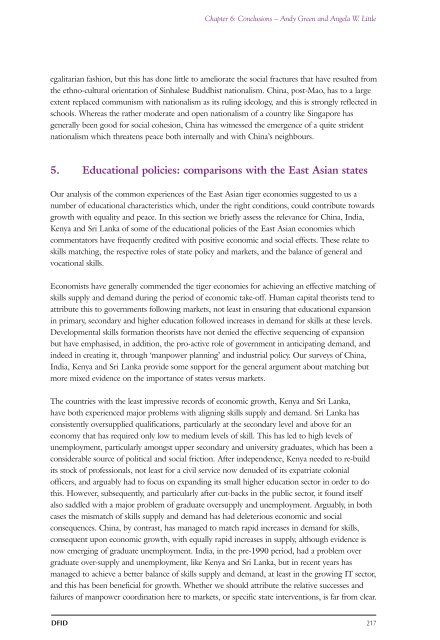education-dev-global-era-69
education-dev-global-era-69
education-dev-global-era-69
Create successful ePaper yourself
Turn your PDF publications into a flip-book with our unique Google optimized e-Paper software.
Chapter 6: Conclusions – Andy Green and Angela W. Littleegalitarian fashion, but this has done little to ameliorate the social fractures that have resulted fromthe ethno-cultural orientation of Sinhalese Buddhist nationalism. China, post-Mao, has to a largeextent replaced communism with nationalism as its ruling ideology, and this is strongly reflected inschools. Whereas the rather mod<strong>era</strong>te and open nationalism of a country like Singapore hasgen<strong>era</strong>lly been good for social cohesion, China has witnessed the emergence of a quite stridentnationalism which threatens peace both internally and with China’s neighbours.5. Educational policies: comparisons with the East Asian statesOur analysis of the common experiences of the East Asian tiger economies suggested to us anumber of <strong>education</strong>al characteristics which, under the right conditions, could contribute towardsgrowth with equality and peace. In this section we briefly assess the relevance for China, India,Kenya and Sri Lanka of some of the <strong>education</strong>al policies of the East Asian economies whichcommentators have frequently credited with positive economic and social effects. These relate toskills matching, the respective roles of state policy and markets, and the balance of gen<strong>era</strong>l andvocational skills.Economists have gen<strong>era</strong>lly commended the tiger economies for achieving an effective matching ofskills supply and demand during the period of economic take-off. Human capital theorists tend toattribute this to governments following markets, not least in ensuring that <strong>education</strong>al expansionin primary, secondary and higher <strong>education</strong> followed increases in demand for skills at these levels.Developmental skills formation theorists have not denied the effective sequencing of expansionbut have emphasised, in addition, the pro-active role of government in anticipating demand, andindeed in creating it, through ‘manpower planning’ and industrial policy. Our surveys of China,India, Kenya and Sri Lanka provide some support for the gen<strong>era</strong>l argument about matching butmore mixed evidence on the importance of states versus markets.The countries with the least impressive records of economic growth, Kenya and Sri Lanka,have both experienced major problems with aligning skills supply and demand. Sri Lanka hasconsistently oversupplied qualifications, particularly at the secondary level and above for aneconomy that has required only low to medium levels of skill. This has led to high levels ofunemployment, particularly amongst upper secondary and university graduates, which has been aconsid<strong>era</strong>ble source of political and social friction. After independence, Kenya needed to re-buildits stock of professionals, not least for a civil service now denuded of its expatriate colonialofficers, and arguably had to focus on expanding its small higher <strong>education</strong> sector in order to dothis. However, subsequently, and particularly after cut-backs in the public sector, it found itselfalso saddled with a major problem of graduate oversupply and unemployment. Arguably, in bothcases the mismatch of skills supply and demand has had deleterious economic and socialconsequences. China, by contrast, has managed to match rapid increases in demand for skills,consequent upon economic growth, with equally rapid increases in supply, although evidence isnow emerging of graduate unemployment. India, in the pre-1990 period, had a problem overgraduate over-supply and unemployment, like Kenya and Sri Lanka, but in recent years hasmanaged to achieve a better balance of skills supply and demand, at least in the growing IT sector,and this has been beneficial for growth. Whether we should attribute the relative successes andfailures of manpower coordination here to markets, or specific state interventions, is far from clear.DFID 217





